Synthetic Cannabinoids: JWH-018 Replacements
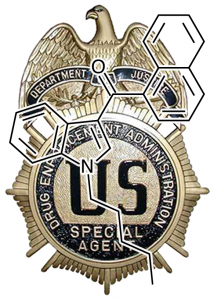
On November 24, 2010, the DEA used its emergency scheduling authority to temporarily control JWH-018, JWH-073, JWH-200, CP-47,497, and cannabicyclohexanol, synthetic cannabinoids used as cannabis substitutes. If history is any guide, this tempory control will soon become permanent. The major motivations for this action appeared to be twofold. First, use among members of the military had become increasingly prevalent as these compounds produced metabolites that did not flag typical drug tests. Secondly, the high potency and full agonism of certain compounds (particularly JWH-018) could lead to states of anxiety in higher doses. While a temporary mental state and not reflective of any physical toxicity, hospitals began reporting an increase in admissions and emergency calls from primarily inexperienced and younger users in the midst of a wigout. Despite a complete lack of quantifiable mental or physical harm, this led to media demonization as a “dangeous drug available to teens”.
So the DEA intervened, but there’s just one problem. The synthetic cannabinoids emergency scheduled are a tiny fraction of literally thousands of related compounds known to science - with more being discovered every day. So what are some of the cannabinoids currently on the market that slide in under the radar?
|
JWH-018 (CB1 Ki = 9.00 nM, CB2 Ki = 2.94 nM) The most famous alkylated naphthoylindole, doomed to criminalization in the United States, and included here as a structural reference. |

|
|
JWH-019 (CB1 Ki = 9.80 nM, CB2 Ki = 5.55 nM) Poor JWH-019. An alkylated naphthoylindole just like its butyl (JWH-073) and pentyl (JWH-018) brothers, they rose to fame while it languished in obscurity. A less anxiety prone and more cerebral headspace combined with a marginal decrease in potency relative to JWH-018 could lead to the last still-legal homologue of the family finally getting its dues. |
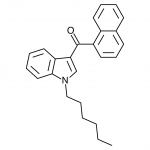
|
|
JWH-081 (CB1 Ki = 1.20 nM, CB2 Ki = 12.4 nM) If we look at the structure of JWH-081, we can see that it is very similar to JWH-018 with the exception of the methoxy group. Unlike JWH-018 however, it is more selective for the CB1 receptor which appears to be correlated with reduced anxiety (like JWH-073). A less trippy headspace with more physical stoning effects, and mild euphoria. |
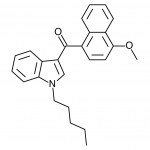
|
|
JWH-250 (CB1 Ki = 11 nM, CB2 Ki = 33 nM) Replace the notorious napthalene ring of JWH-018 with a 2′-methoxyphenylacetyl group and you get JWH-250, a rising star. Unlike other synthetic cannabinoids which produce a more indica-style headspace, JWH-250 produces an effect somewhat similar to JWH-018 with a clear, soaring, sativa charactered stone. |
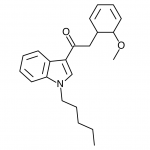
|
|
RCS-4 (BTM-4, SR-19) (CB1 Ki = ?? nM, CB2 Ki = ?? nM) With a structure reminiscent of JWH-081 if we chopped its napthyl in half to produce a phenyl group, this synthetic cannabinoid has similar potency and effects to JWH-018, all allegedly without legal issues or the infamous JWH “fear”. Interestingly enough this seems to be the result of independent research seeking new psychoactive (and profitable) cannabinoids, and not simply someone pinching from academic journal articles. Prohibition made the production of these cannabinoids a huge cash cow, and now a self-sustaining independent industry with very credible players has been born. |
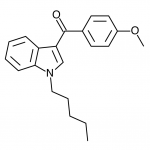
|
|
AM-694 (CB1 Ki = 0.08 nM, CB2 Ki = 1.44 nM) A hyperpotent cannabinoid based on CB1 binding affinity, with a fluorine on the end of the pentyl chain in an apparent attempt to increase duration of effect. This raised some eyebrows when it first appeared with concerns about possible metabolism to toxic fluoroacetate. Luckily it appears that the odd-numbered (pentyl) chain means that the less toxic 3-fluoropropanoic acid will likely be produced instead. The choice of this compound for wide distribution rather than other alternatives raises questions, as the emphasis on duration and potency seem to reveal a focus on profit rather than quality of headspace. |
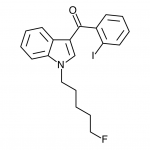
|
This should not be considered anywhere near a complete list of compounds currently available in the marketplace, and is an even tinier slice of the vast number known to produce pleasurable psychoactive effects. It seems unlikely that a blanket approach based on criminalization will be practical, as a large number of related compounds have demonstrated breakthrough benefit in treating afflictions such as Alzheimer’s and cancer. There is simply too much money to be made with these new medicines that would be caught in the net, and legislators are aware of this.
What seems more likely is an uneasy truce between synthetic cannabinoid producers and the DEA based on certain criteria. If the producers are sensible enough to avoid explicit sales to military personnel and teens resulting in decreased media attention, they will likely be ignored. Synthetic cannabinoids preparations sold on a retail level (“herbal incence” products) will likely be seized for “investigation” regardless of the legality of the active ingredient, as inventory tied up in evidence lockers will result in cost pressures almost as effective as an actual ban. Existing distributors are likely to move toward larger scale sale of explicitly unscheduled cannabinoids, allowing greed to motivate new smaller players to move into the now excessive scrutiny of retail level distribution.


Awesome article, Ninja! I read in some forums that rcs 4 & 5 r so similar in structure that they could be seen as analogs of jwh-018?
Also, great point about them taking “any questionable” herbs off the shelf and having them on “eternal holding pattern” for testing. What a great way to abuse ur authority.
KiDWoK
I don’t know if I’d go that far myself. I personally think that it is one of the more unique compounds structurally, simply due to the lack of a napthyl moiety. These comments may be a result of the fact that RCS-4 has origins with a single lab, and competitors have an incentive to talk it down. If RCS-4 goes down as an analog of JWH-018 (rather than being explicitly scheduled itself), so do a huge number of other compounds - and I think the pharmaceutical industry and the legislators in their pocket are too interested in the profit potential of CB2 agonists like JWH-133 that would fall under that wide umbrella.
i live in OK,,, and have been enjoying the herbal incense for years,, i am having great trouble finding any with any potency anymore,, could i please have some solid advice on where?what ? i could purchase either online or otherwise that would deliver the effect/headspace that i am wanting. it seems nobody will say what active ingredient anymore is ,, and im tired of wasting money,, please help
I will help you out there. You want A-834,735. It works on both canabinoids receptors simultaniously and works fast. It is strong but AK-8 is my favorite. I only know of 1 man who has that and he is out of biz. AK-8 lasts 5 times longer than A-834,735 but has equal or greater potency. Get that, use 1 gram per oz. of herbs. I like using Siberian motherwort , Damiana, blue lotus, and mugwort as my blend. Works well and for less than $15 you got an ounce. Have fun and you are very welcome for the help no thanks needed. Just remember that A-834,735 is very difficult to dissolve in Everclear but I would suggest never using acetone. Just dissolve what you can in Everclear and then sprinkle the rest some her and there on the herbs as you spray it down and never forget to mix herbage well during and let dry thoroughly. Love you blend and always remember that the man who told you about it was the greatest guy you have ever known to exist. Also, I am a chemistry student so this was done under very controlled conditions and for research only as an aid for depression.